nForce2 6-way Motherboard Roundup - December 2002
by Evan Lieb on December 4, 2002 6:53 PM EST- Posted in
- Motherboards
ABIT NF7-S: BIOS and Overclocking
ABIT utilizes their own modified BIOS, dubbed Soft Menu III. Soft Menu III has been a huge hit among enthusiasts, so we had high hopes for ABIT's nForce2 BIOS.

The Winbond W83627HF I/O chip powers the PC Health section of the Soft Menu III BIOS.
You'll find lots of readings in the PC Health section of Soft Menu III, including System and CPU temperatures, fan speeds (CPU, chassis and power), Vcore, PSU readings (all rails), and battery and standby voltage readings. In addition to the PC Health readings, you'll find options for enabling CPU shutdown temperature and adjusting CPU warning temperature. All in all, this is a common hardware monitor to have for a high-performance motherboard.
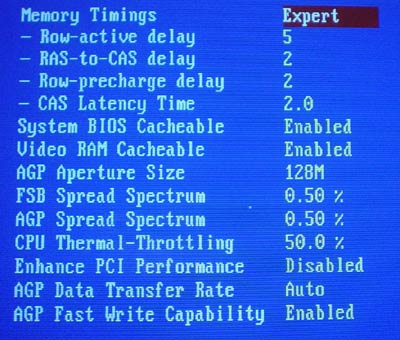
The Advanced Chipset Features section doesn't contain as many options as the other nForce2 BIOSes do, but this can be attributed to the fact that this is the only Advanced Chipset Features section of the nForce2 BIOSes that has been significantly modified from NVIDIA's original Advanced Chipset Features layout. ABIT does this by separating the DRAM timings from all other frequency adjustment options (including FSB, memory, etc.).
The Advanced Chipset Features section contains options for adjusting Precharge to Active, Active to Precharge, Active to CMD, and CAS Latency among other minor adjustments. Interestingly enough, the Active to Precharge timing can be adjusted as low as 1T, and up to 15T in fact. Though it's obviously not possible to get to 1T, we were able to go as low as 4T.
What's unique about nForce2 BIOSes versus VIA, SiS and Intel BIOSes is the "CPU Interface" option, which can either be enabled or disabled. Enabling CPU Interface does add some noticeable performance as far as actual benchmark numbers are concerned, but the real world difference is nonexistent. We actually first saw this "feature" on NVIDIA's reference board, which indicated that it simply tuned FSB performance. We saw no degradation of stability in any of our tests but again, the performance increase is only there in the benchmarks and isn't really tangible to end users so enable it at your own risk.
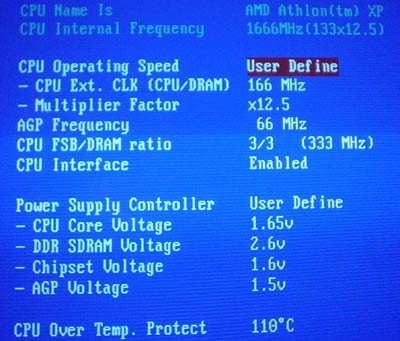
The "Soft Menu III" section listed at the very top of the NF7-S BIOS contains all the frequency adjustments you would normally find in the Advanced Chipset Features section of other nForce2 motherboard BIOSes. In "Soft Menu III" you'll find options for tweaking the FSB up to 237MHz in 1MHz increments, AGP up to 99MHz in 1MHz increments, multipliers ranging from 5X to 22X, FSB/DRAM dividers, and of course the CPU Interface. As is common with nForce2 BIOSes, there are "Optimal" and "Aggressive" options that automatically adjust various settings in the Advanced Chipset Features section. However, we suggest you simply select the "Expert" option for full customization, assuming you have some experience with BIOS tweaking.
There are also some fairly nice voltage options buried inside the Soft Menu III section. For example, Vcore is adjustable in .025V increments all the way up to 1.85V. This maximum Vcore isn't all that great, especially if you plan on using a .18-micron Palomino processor (whose default Vcore is 1.75V). However, Thoroughbred-B users should do quite well with a max of 1.85V, especially since running your CPU higher than 1.85V can be detrimental to the longevity of the CPU's lifespan.
 |
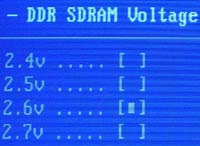 |
VDIMM is yet another adjustable option in the Soft Menu III section. VDIMM can be altered up to 2.7V in 0.1V increments, which is just fine for most users. Memory overvolting usually doesn't yield too much better of a memory overclock anyways, so there's nothing to worry about there.
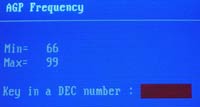
The NF7-S BIOS version we received contained an AGP lock set at 66MHz, but we were unable to find any PCI lock set at 33MHz in this BIOS. We asked ABIT why the AGP lock was included in the NF7-S BIOS but not the PCI lock, and we were basically told that the only reason you don't see a PCI lock in the BIOS is because ABIT doesn't want users fooling around with PCI frequency, especially since it offers virtually no performance gain. We don't have any way of independently verifying ABIT's PCI lock claim ourselves, so take this piece of information as you will.
As with all the nForce2 motherboards tested here today, it was very easy to overclock the NF7-S. Here were our FSB overclocking results using the following setup:
|
Front Side Bus Overclocking Testbed |
|
|
Processor:
|
Athlon
XP 2400+
|
|
CPU
Vcore:
|
1.65V
|
|
Cooling:
|
AMD
Retail HSF & Thermal Pad
|
|
Power
Supply:
|
Enermax
300W
|
With this very common, and therefore quite conservative, overclocking setup we were able to hit 186MHz FSB. This is a very good overclock and is the norm for all nForce2 boards tested here today.
We'd quickly like to mention something before we go on. The great thing about Athlon XP processors is that they can be unlocked (unlike modern-day Intel CPUs), and being able to unlock a processor is a boon for computer hardware review sites such as AnandTech, as it gives us the ability to test the true maximum FSB a particular motherboard can handle.
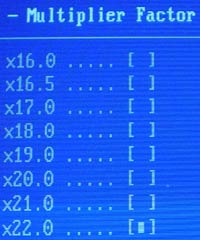
For our overclocking tests on the NF7-S, we simply lowered the multiplier of our 2400+ processor down to 8X and jacked up the FSB as high as we could, which ended up being 186MHz FSB in the NF7-S' case (or 186MHz X 8.0).

The divider options available in the NF7-S BIOS are very good; quite a few memory tweakers should be delighted to see the huge array of memory dividers options available on this motherboard. Just some of the many available memory divider options include 4:5, 3:4 and 1:1. For a more complete list, see the above picture.


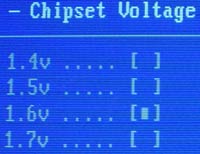
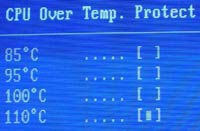









1 Comments
View All Comments
c627627 - Monday, July 21, 2003 - link
MSI contradicts your reviewhttp://www.anandtech.com/mb/showdoc.html?i=1759&am...
You say:
"12/04/02 UPDATE: MSI sends word that the K7N2-L indeed does not have a PCI bus lock at 33MHz."
To this day, that was used as ultimate proof that the original MSI nForce2 mobo does not have a PCI lock.
Today MSI Senior Moderators said:
"they are wrong,and who ever told them it did not from msi"
(!)
Source:
http://www.msi.com.tw/program/e_service/forum/thre...
Won't you please settle this for us.